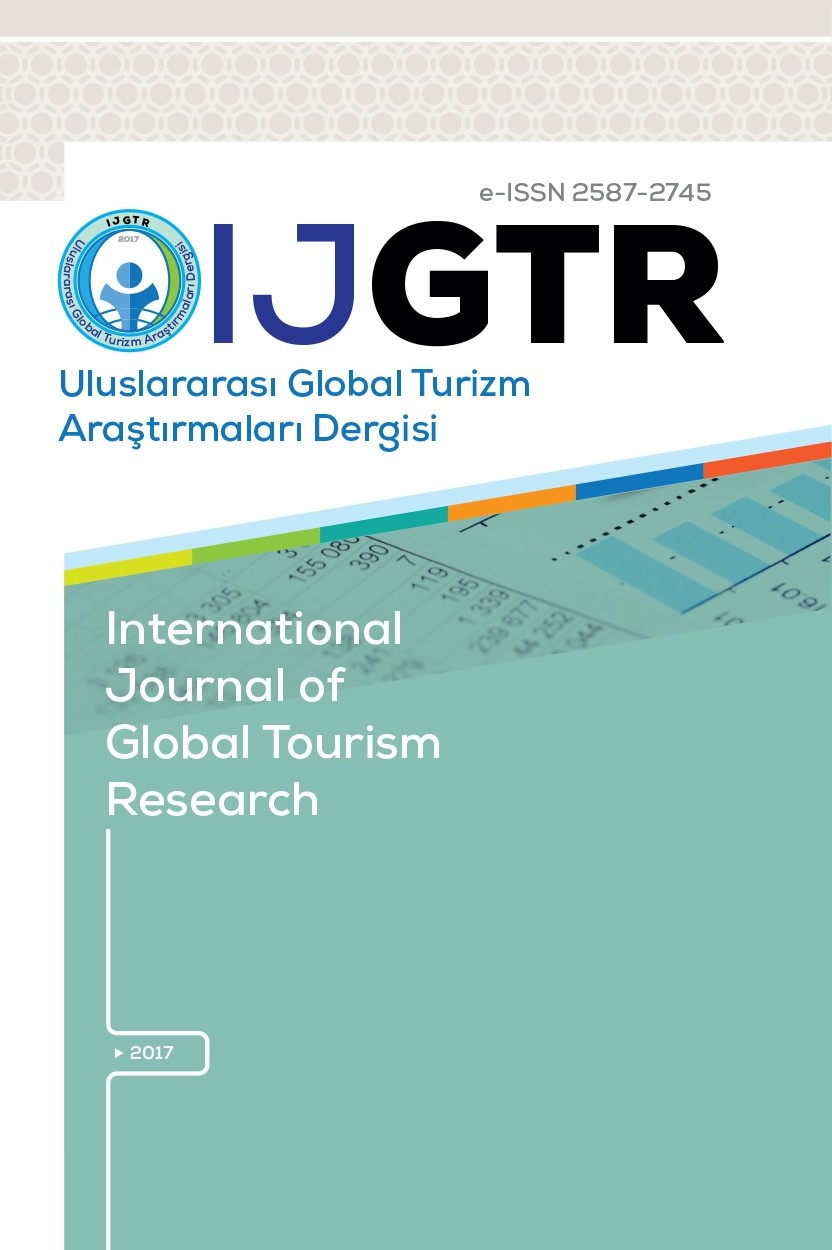FESTİVAL KALİTESİNİN TURİSTLERİN BAĞLILIKLARINA ETKİSİ BURHANİYE DEVE GÜREŞLERİ FESTİVALİ ÖRNEĞİ
Bu çalışmanın amacı, festivallere katılan turistlerin algıladıkları festival kalitesinin, festival bağlılıkları üzerindeki etkisinin araştırılmasıdır. Araştırma, Balıkesir ili Burhaniye İlçesinde yapılan deve güreşi festivallerinde 400 turistle yüz yüze görüşülerek gerçekleştirilmiştir. Yapılan değerlendirme sonucunda 374 anket formu analize tabi tutulmuştur. Araştırma sonucunda festival kalitesi alt boyutlarından reklam ve tanıtım ile tesis imkânları boyutlarının festival bağlılığı üzerinde pozitif ve anlamlı bir etkisi olduğu, yiyecek içecek ikramlarının ise negatif ve anlamlı bir etkisi olduğu sonucuna varılmıştır. Elde edilen bulgular yorumlanarak Türkiye’de düzenlenen festivallerde görev alan yöneticiler ve araştırmacılar için öneriler sunulmuştur.
Anahtar Kelimeler:
Festival Turizmi, Kalite, Bağlılık, Burhaniye, Balıkesir
IMPRESSION OF FESTIVAL’S QUALITY ON TOURISTS’ LOYALTY: BURHANIYE CAMEL WRESTLING FESTIVAL EXAMPLE
The purpose of the study, to investigate of festival quality, that is perceived by participant tourists, on loyalty of festival. Survey, was made face to face with 400 tourists who participate to camel wrestling in Balıkesir, Burhaniye. As a result of the investigation, 374 survey forms were conducted. Are concluded that; dimensions of advertisement and production which is from the sub-dimensions of festival’s quality, and also capacity of facility have positive and meaningful effects, but catering services have negative and meaningful effects. After interpretion of the findings, we bring forward a proposal to directors and researchers who take charge in these kinds of festivals.
Keywords:
Tourism of Festival, Quality, Loyalty, Burhaniye,
___
- Avraham, E. (2004). Media strategies for improving an unfavorable city image, Cities. 21(6): 471- 479.
- Aydin, S. ve Özer, G. (2005). The analysis of antecedents of customer loyalty in the Turkish mobile telecommunication market, European Journal of Marketing, 39(7/8): 910-925.
- Barutçu, S. (2007). GSM sektöründe müşteri bağlılığı (Pamukkale üniversitesi öğrencilerinin gsm operatörlerine bağlılıkları ve bağlılıklarını etkileyen faktörler). Afyon Kocatepe Üniversitesi, İ.İ.B.F. Dergisi, 9 (1): 349 372.
- Bloemer, J. Ruyter, K. ve Wetzels, M. (1999). Linking perceived service quality and service loyalty: a multi-dimensional perspective. European Journal of Marketing, 33 (11/12): 1082 1106.
- Bowen, J. T. ve Chen S. L. (2001). The relationship between customer loyalty and customer satisfaction. International Journal of Contemporary Hospitality Management, 13 (5): 213 217.
- Chang, H.-S. Chen, T.-Y. ve Tseng, C.-M. (2009). How cause re¬lated marketing ınfluence customer value in banking ın¬dustry. Contemporary Management Research, 5 (4): 343-368.
- Clottey, T. A. Collier, D. A.ve Stodnick, M. (2008). Drivers of customer loyalty in a retail store environment. Journal of Service Science, 1 (1): 35 48.
- Çulha, O. (2008). Kültür turizmi kapsamında destekleyici turistik ürün olarak deve güreşi festivalleri üzerine bir alan çalışması. Journal of Yasar University, 3(12): 1827-1852.
- Duffy, M. (2005). Performing identity within a multicultural framework. Social And Cultural Geography, 6 (5): 677-692.
- Fornell, C. ve Larcker, D.F.(1981). Structural equation models with unobservable variables and measurement error: algebra and statistics. Journal of Marketing Research, 18(3):382-388.
- Giritlioğlu, İ., Olcay, A. ve Özekici, Y. K. (2005). Bir turizm çeşitliliği olarak festival etkinliklerinin sınıflandırılması: Türkiye üzerine bir değerlendirme, Sosyal Bilimler Araştırmaları Dergisi,(13): 306-323.
- Grönroos, C. (2000). Service Management and Marketing: A Customer Relationship Management Approach, Second Edition, UK: John Wiley & Sons Ltd.
- Gül K., Erdem, B., ve Gül, M. (2013). Yerel festivallerin etkinliğine bağlı ziyaretçi kazanımları: Sındırgı Yağcıbedir festivali örneği. Süleyman Demirel Üniversitesi İktisadi ve İdari Bilimler Fakültesi Dergisi, 18(2):213-239.
- Houghton, M. (2001). The propensity of wine festivals to encourage subsequent winery visitation. International Journal of Wine Marketing, 13 (3): 32 – 41.
- Kim, W. G. ve Kim, H. B. (2004). Measuring customer-based restaurant brand equity. Cornell Hotel and Restaurant Administration Quarterly, 45(2): 115-131.
- Kouthouris, C. ve Alexandris, K. (2005). Can service quality predict customer satisfaction and behavioral ıntentions in the sport tourism ındustry an application of the servqual model in an outdoors setting. Journal of Sport Tourism, 10(2): 101–111
- Litvin, S. W. ve Fetter, E. (2006). Can a festival be too successfull a review of spoleto, Usa. International Journal of Contemporary Hospitality Management, 18 (1): 41 – 49.
- McClinchey, K. A. (2008). Urban ethnic festivals, neighborhoods, and the multiple realities of marketing place. Journal of Travel and Tourism Marketing, 25(3-4): 251-264.
- Özdemir, G. ve Çulha, O. (2009). Satisfaction and loyality of festival visitors. Anatolia: An International Journal Of Tourism And Hospitality Research, 20(2): 359-373.
- Pasanen, K. Taskinen, H. ve Mikkonen, J. (2009). Impacts of cultural events in eastern Finland – development of a finnish event evaluation too. Scandinavian Journal of Hospitality and Tourism, 9, (2–3): 112–129.
- Reid, S. (2007). Identifying social consequences of rural events. Event Management, 11(1): 89-98.
- Rust, R. T. Antony J. Z. ve Timothy L. K. (1996). Service Marketing, USA: Harpercollins College Publishers.
- Szwarch, P. (2005), Researching Customer Satisfaction And Loyalty: How To Find Out What People Really Think, USA: Kogan Page Ltd.
- Tayfun, A., ve Arslan, E. (2013). Festival turizmi kapsamında yerli turistlerin ankara alışveriş festivali’nden memnuniyetleri üzerine bir araştırma. İşletme Araştırmaları Dergisi, 5(2): 192-206.
- Yavuz, M. C. (2007). Uluslararası Destinasyon Markası Oluşturulmasında Kimlik Geliştirme Süreci: Adana Örneği, (Yayınlanmamış Doktora Tezi). Çukurova Üniversitesi Sosyal Bilimler Enstitüsü. Adana.
- Yoo-S. Y., Jin-S. L. ve Choong-K. L. (2010). Measuring festival quality and value affecting visitors’ satisfaction and loyalty using a structural approach. International Journal of Hospitality Management, 29 (2): 335-342.
- http://www.tdk.org.tr/index.php?option=com_gts&arama=gts&guid=TDK.GTS.5a346232ade720.85941148 Erişim Tarihi: 20.09.2017
- Başlangıç: 2017
- Yayıncı: Gülay BULGAN
Sayıdaki Diğer Makaleler
FESTİVAL KALİTESİNİN TURİSTLERİN BAĞLILIKLARINA ETKİSİ BURHANİYE DEVE GÜREŞLERİ FESTİVALİ ÖRNEĞİ
Muammer BEZİRGAN, Fatih ÇOLAKOĞLU
TURİST REHBERLERİNİN DUYGUSAL ZEKÂ DÜZEYLERİNİN BELİRLENMESİNE YÖNELİK BİR ARAŞTIRMA
Mehmet Teoman TÜRKMEN, Özlem KÖROĞLU
BÖLGESEL KALKINMA VE TURİZM İLİŞKİSİ: TR61 BÖLGESİ ÜZERİNE BİR DEĞERLENDİRME
Ayşegül BAYKUL, Selen IŞIK MADEN
TÜRKİYE’DE MEDİKAL TURİZMİN GELİŞİMİ VE BAZI ÜLKELERLE KARŞILAŞTIRILMASI
